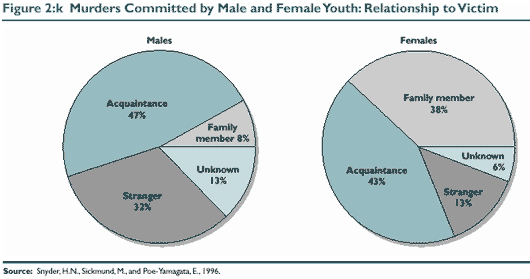Chapter 2: Jurisdictional and Program Self-Assessment
Consequences of Juvenile Delinquency and Violence
Youth, their families, and society suffer multiple consequences from juvenile crime and related problems. Both human and economic costs are significant.
The most profound consequence of juvenile crime is the loss of human life. In 1998, law enforcement made approximately 2,100 juvenile arrests for murder and nonnegligent manslaughter. There was a 48-percent decline in juvenile arrests for murder between 1994 and 1998. After increasing substantially between 1987 and 1993, the juvenile arrest rate for murder declined each year through 1998. This large decline brought the arrest rate back to the levels of the mid-1980's (Snyder, 1999).
There are interesting differences among the victims of fatal violence perpetrated by male and female youth, as illustrated in Figure 2:k (Snyder, Sickmund, and Poe-Yamagata, 1996). Aside from the preponderance of acquaintance-victims, males and females tended to kill different types of victims. Females were more likely than males to kill family members, whereas males were more likely than females to kill strangers.

Juveniles also are victims of homicide. Between 1980 and 1994, murders of juveniles between the ages of 12 and 17 increased 95 percent, resulting in an average of 7 juvenile homicides each day. Not all of these murders were perpetrated by other juveniles. However, nearly half of the victims murdered by juvenile offenders were between ages 15 and 24. In 1993, nearly 75 percent of the juvenile victims were male, and the rate of homicide for African American youth was six times greater than the rate for White youth. In fact, the highest murder rate was that of African American male victims killed by African American male perpetrators.
Other crimes committed by juveniles also carry both economic and psychological burdens. Youth disproportionately commit arson, vandalism, motor vehicle thefts, burglaries, and larceny/thefts with resultant financial ramifications for victims. Medical and other treatment expenses for victims of robberies, rapes, and assaults also are significant. Families, particularly, may face distress and added expenses when youth use alcohol or other drugs or run away from home.
Social costs of delinquency are also significant. In addition to increased medical expenses and lost years of productivity for both offenders and victims, there are tremendous costs related to providing juvenile justice services. As previously mentioned, incarceration of a juvenile offender for 1 year costs, on average, about $36,500 (Corrections Yearbook, 1995).
| Jurisdictional Technical Assistance Package for Juvenile Corrections | Report - December 2000 |